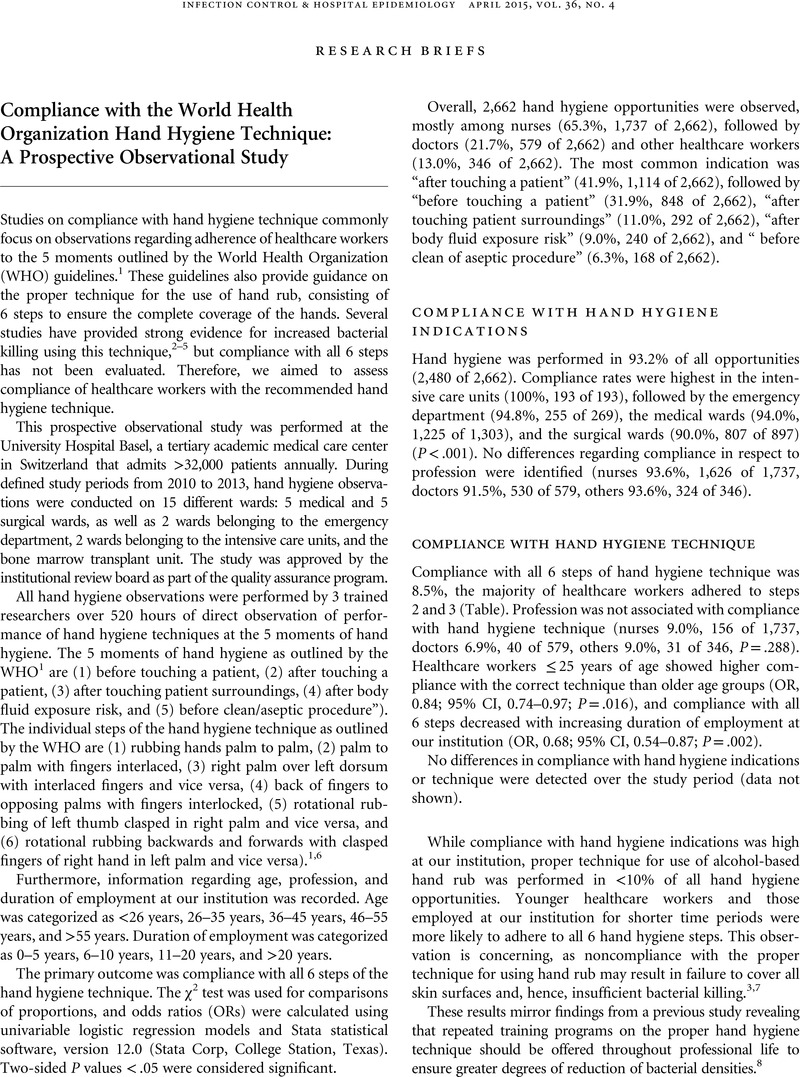Crossref Citations
This article has been cited by the following publications. This list is generated based on data provided by Crossref.
Widmer, Andreas F.
and
Tschudin-Sutter, Sarah
2015.
Letter to the Editor Regarding “Efficacy of Alcohol Gel for Removal of Methicillin-Resistant Staphylococcus Aureus from Hands of Colonized Patients”.
Infection Control & Hospital Epidemiology,
Vol. 36,
Issue. 7,
p.
854.
Haubitz, Sebastian
Atkinson, Andrew
Kaspar, Tanja
Nydegger, Doris
Eichenberger, Anne
Sommerstein, Rami
and
Marschall, Jonas
2016.
Handrub Consumption Mirrors Hand Hygiene Compliance.
Infection Control & Hospital Epidemiology,
Vol. 37,
Issue. 6,
p.
707.
Tschudin-Sutter, Sarah
Frei, Reno
Schwahn, Friedbert
Tomic, Milanka
Conzelmann, Martin
Stranden, Anne
and
Widmer, Andreas F.
2016.
Prospective Validation of Cessation of Contact Precautions for Extended-Spectrum β-Lactamase–ProducingEscherichia coli1.
Emerging Infectious Diseases,
Vol. 22,
Issue. 6,
p.
1094.
Arias, Ariadna V.
Garcell, Humberto G.
Ochoa, Yagdeline R.
Arias, Katiana F.
and
Miranda, Fernando R.
2016.
Assessment of hand hygiene techniques using the World Health Organization's six steps.
Journal of Infection and Public Health,
Vol. 9,
Issue. 3,
p.
366.
Boyce, John M.
2017.
Electronic monitoring in combination with direct observation as a means to significantly improve hand hygiene compliance.
American Journal of Infection Control,
Vol. 45,
Issue. 5,
p.
528.
Wetzker, Wibke
Walter, Janine
Bunte-Schönberger, Karin
Schwab, Frank
Behnke, Michael
Gastmeier, Petra
and
Reichardt, Christiane
2017.
Hand Rub Consumption Has Almost Doubled in 132 German Hospitals Over 9 Years.
Infection Control & Hospital Epidemiology,
Vol. 38,
Issue. 7,
p.
870.
Pires, Daniela
Bellissimo-Rodrigues, Fernando
Soule, Hervé
Gayet-Ageron, Angèle
and
Pittet, Didier
2017.
Revisiting the WHO “How to Handrub” Hand Hygiene Technique: Fingertips First?.
Infection Control & Hospital Epidemiology,
Vol. 38,
Issue. 2,
p.
230.
Pougnet, Richard
and
Pougnet, Laurence
2017.
Attire as a Fomite: Proposal for a New Index Concerning Change of Attire.
Infection Control & Hospital Epidemiology,
Vol. 38,
Issue. 5,
p.
629.
Pires, Daniela
Soule, Hervé
Bellissimo-Rodrigues, Fernando
Gayet-Ageron, Angèle
and
Pittet, Didier
2017.
Hand Hygiene With Alcohol-Based Hand Rub: How Long Is Long Enough?.
Infection Control & Hospital Epidemiology,
Vol. 38,
Issue. 5,
p.
547.
Tschudin-Sutter, S.
Rotter, M.L.
Frei, R.
Nogarth, D.
Häusermann, P.
Stranden, A.
Pittet, D.
and
Widmer, A.F.
2017.
Simplifying the WHO ‘how to hand rub’ technique: three steps are as effective as six—results from an experimental randomized crossover trial.
Clinical Microbiology and Infection,
Vol. 23,
Issue. 6,
p.
409.e1.
Widmer, Andreas F.
and
Solomkin, Joseph
2017.
Hand Hygiene.
p.
94.
Bierwirth, Janine
and
Schulz-Stübner, Sebastian
2017.
Subjective Qualitative Hand Hygiene Compliance Observation: A Feasibility Trial.
Infection Control & Hospital Epidemiology,
Vol. 38,
Issue. 2,
p.
251.
Jain, Susan
Clezy, Kate
and
McLaws, Mary-Louise
2018.
Safe removal of gloves from contact precautions: The role of hand hygiene.
American Journal of Infection Control,
Vol. 46,
Issue. 7,
p.
764.
Price, Lesley
MacDonald, Jennifer
Gozdzielewska, Lucyna
Howe, Tracey
Flowers, Paul
Shepherd, Lesley
Watt, Yvonne
and
Reilly, Jacqui
2018.
Interventions to improve healthcare workers’ hand hygiene compliance: A systematic review of systematic reviews.
Infection Control & Hospital Epidemiology,
Vol. 39,
Issue. 12,
p.
1449.
Staines, A.
Vanderavero, P.
Duvillard, B.
Deriaz, P.
Erard, P.
Kundig, F.
Juillet, C.
and
Clerc, O.
2018.
Sustained improvement in hand hygiene compliance using a multi-modal improvement programme at a Swiss multi-site regional hospital.
Journal of Hospital Infection,
Vol. 100,
Issue. 2,
p.
176.
Lacey, Gerard
Showstark, Mary
and
Van Rhee, James
2019.
Training to Proficiency in the WHO Hand Hygiene Technique.
Journal of Medical Education and Curricular Development,
Vol. 6,
Issue. ,
p.
238212051986768.
Pires, D.
Soule, H.
Bellissimo-Rodrigues, F.
de Kraker, M.E.A.
and
Pittet, D.
2019.
Antibacterial efficacy of handrubbing for 15 versus 30 seconds: EN 1500-based randomized experimental study with different loads of Staphylococcus aureus and Escherichia coli.
Clinical Microbiology and Infection,
Vol. 25,
Issue. 7,
p.
851.
Tschudin-Sutter, Sarah
Sepulcri, Daniel
Dangel, Marc
Ulrich, Anja
Frei, Reno
and
Widmer, Andreas F
2019.
Simplifying the World Health Organization Protocol: 3 Steps Versus 6 Steps for Performance of Hand Hygiene in a Cluster-randomized Trial.
Clinical Infectious Diseases,
Vol. 69,
Issue. 4,
p.
614.
Loftus, Michael J.
Guitart, Chloe
Tartari, Ermira
Stewardson, Andrew J.
Amer, Fatma
Bellissimo-Rodrigues, Fernando
Lee, Yew Fong
Mehtar, Shaheen
Sithole, Buyiswa L.
and
Pittet, Didier
2019.
Hand hygiene in low- and middle-income countries.
International Journal of Infectious Diseases,
Vol. 86,
Issue. ,
p.
25.
Boyce, John M.
2019.
Current issues in hand hygiene.
American Journal of Infection Control,
Vol. 47,
Issue. ,
p.
A46.





